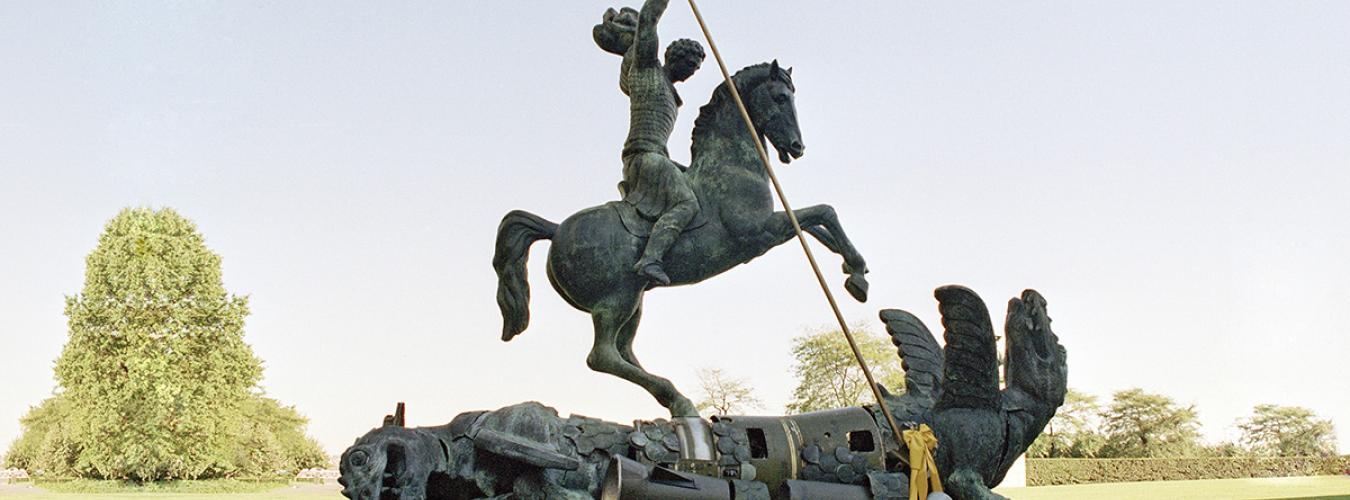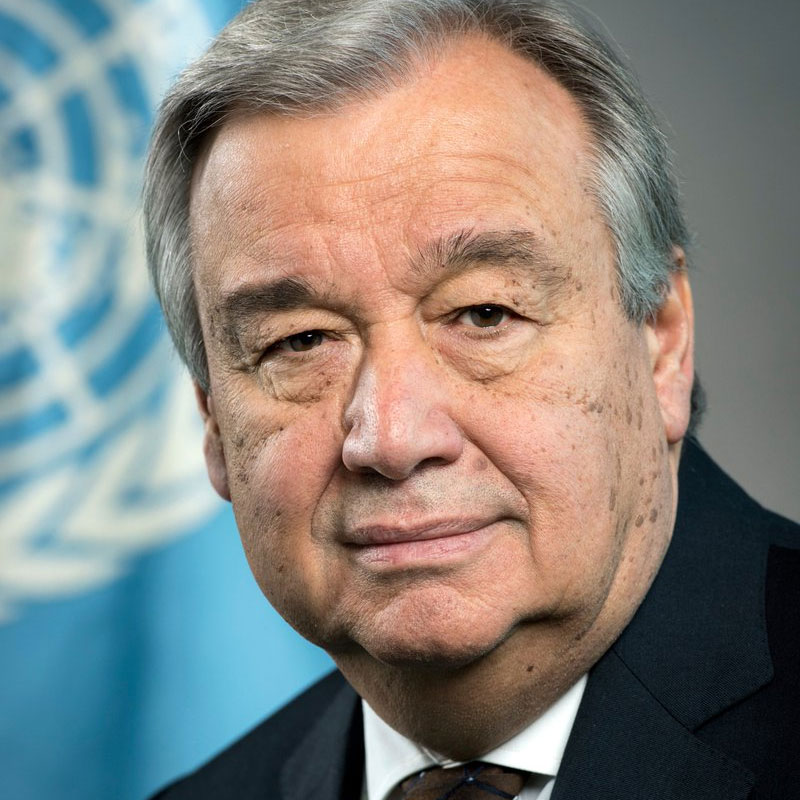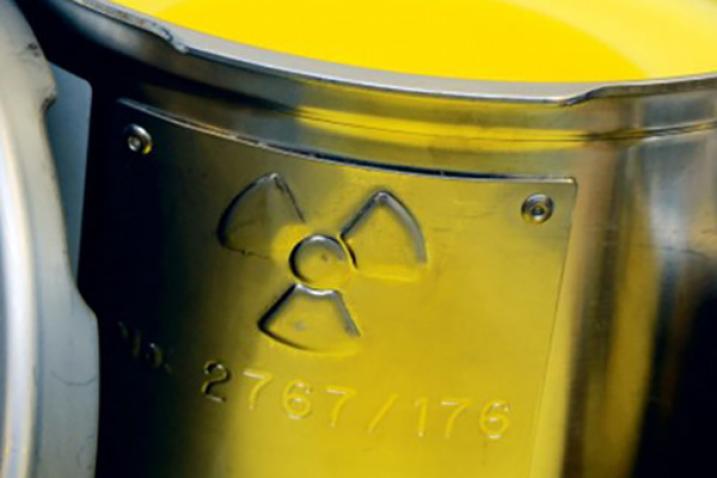Achieving global nuclear disarmament is the highest disarmament priority of the United Nations. It was the subject of the General Assembly’s first resolution in 1946, which established the Atomic Energy Commission (dissolved in 1952), with a mandate to make specific proposals for the control of nuclear energy and the elimination of atomic weapons and all other major weapons adaptable to mass destruction. The United Nations has been at the forefront of many major diplomatic efforts to advance nuclear disarmament since. In 1959, the General Assembly endorsed the objective of general and complete disarmament. In 1978, the first Special Session of the General Assembly Devoted to Disarmament further recognized that nuclear disarmament should be the priority objective in the field of disarmament. Every United Nations Secretary-General has actively promoted this goal.
Yet, today around 12,512 nuclear weapons remain. Countries possessing such weapons have well-funded, long-term plans to modernize their nuclear arsenals. More than half of the world’s population still lives in countries that either have such weapons or are members of nuclear alliances. While the number of deployed nuclear weapons has appreciably declined since the height of the Cold War, not one nuclear weapon has been physically destroyed pursuant to a treaty. In addition, no nuclear disarmament negotiations are currently underway.
Meanwhile, the doctrine of nuclear deterrence persists as an element in the security policies of all possessor states and many of their allies. The international arms-control framework that contributed to international security since the Cold War, acted as a brake on the use of nuclear weapons and advanced nuclear disarmament, has come under increasing strain. On 2 August 2019, the United States’ withdrawal spelled the end of the Intermediate-Range Nuclear Forces Treaty, through with the United States and the Russian Federation had previously committed to eliminating an entire class of nuclear missiles. Furthermore, the Russian Federation announced on 21 February 2023 that it will suspend its participation in the Treaty on Measures for the Further Reduction and Limitation of Strategic Offensive Arms (“New START”). The extension of New START until February 2026 had provided an opportunity for the possessors of the two largest nuclear arsenals to agree to further arms control measures.
Frustration has been growing amongst Member States regarding what is perceived as the slow pace of nuclear disarmament. This frustration has been put into sharper focus with growing concerns about the catastrophic humanitarian consequences of the use of even a single nuclear weapon, let alone a regional or global nuclear war.
The General Assembly commemorates 26 September as the International Day for the Total Elimination of Nuclear Weapons. This Day provides an occasion for the world community to reaffirm its commitment to global nuclear disarmament as a priority. It provides an opportunity to educate the public - and their leaders - about the real benefits of eliminating such weapons, and the social and economic costs of perpetuating them. Commemorating this Day at the United Nations is especially important, given its universal membership and its long experience in grappling with nuclear disarmament issues. It is the right place to address one of humanity’s greatest challenges; achieving the peace and security of a world without nuclear weapons.
In accordance with General Assembly resolution 68/32 and subsequent resolutions, the purpose of the International Day is to further the objective of the total elimination of nuclear weapons through enhancing public awareness and education about the threat posed to humanity by nuclear weapons and the necessity for their total elimination. In so doing, it is hoped that these activities will help to mobilize new international efforts towards achieving the common goal of a of a nuclear-weapon-free world.
Background
The General Assembly declared the International Day in December 2013, in its resolution 68/32 as a follow-up to the high-level meeting of the General Assembly on nuclear disarmament held on 26 September 2013, in New York.
This was the latest in a series of efforts by the General Assembly to raise public awareness and to seek deeper engagement on nuclear disarmament matters. In 2009, the General Assembly had declared 29 August as the International Day against Nuclear Tests (resolution 64/35).
In resolution 68/32, the General Assembly called for the “urgent commencement of negotiations in the Conference on Disarmament of a comprehensive convention on nuclear weapons to prohibit their possession, development, production, acquisition, testing, stockpiling, transfer and use or threat of use, and to provide for their destruction.”
In 2014, in its resolution 69/58, the General Assembly further expressed its desire to commemorate the Day, and requested the Secretary-General and the President of the General Assembly to make all arrangements necessary to commemorate and promote it, including by convening an annual meeting of the Assembly to commemorate the International Day and to provide a platform for the promotion of these activities. The General Assembly repeated these requests and call in subsequent years in its resolutions 70/34, 71/71, 72/251, 73/40, 74/54, 75/45, and 76/36.
The International Day for the Total Elimination of Nuclear Weapons has been observed annually since 2014. Pursuant to the resolutions of the General Assembly, Member States, the United Nations system and civil society, including non-governmental organizations, academia, parliamentarians, the mass media and individuals are encouraged to commemorate and promote the International Day through enhancing public awareness and education about the threat posed to humanity by nuclear weapons and the necessity for their total elimination.
To observe the International Day, the United Nations is supporting events both in New York and Geneva. United Nations Information Centres around the world are encouraged to raise awareness to the observance of International Day for the Total Elimination of Nuclear Weapons.
Notable Events
1945
The two atomic bombs destroyed the cities of Hiroshima and Nagasaki and are estimated to have killed a total of 213,000 people immediately.
1946
In its very first resolution, the General Assembly identified nuclear disarmament as a leading goal of the United Nations.
1959
The General Assembly included nuclear disarmament as part of the more comprehensive goal of general and complete disarmament under effective international control (resolution 1378(XIV)). It is the first General Assembly resolution ever to be sponsored by the entire membership of the United Nations.
1963
The Treaty Banning Nuclear Weapon Tests in the Atmosphere, in Outer Space and Under Water, also known as the Partial Test Ban Treaty, was opened for signature. Years-long discussions between the Soviet Union, the United Kingdom and the United States had been given a renewed sense of urgency by the Cuban Missile Crisis in 1962.
1967
The nuclear arms race and the 1962 Cuban Missile Crisis prompted Latin American Governments to negotiate the Treaty for the Prohibition of Nuclear Weapons in Latin America and the Caribbean (Treaty of Tlatelolco), which established the first nuclear weapons-free zone in a highly populated area.
1978
The General Assembly held its first Special Session Devoted to Disarmament. In the Final Document, Member States affirmed that their common ultimate objective is “general and complete disarmament under effective international control” and that “effective measures of nuclear disarmament and the prevention of nuclear war have the highest priority.”
1985
The South Pacific became the second nuclear-weapon-free zone (Treaty of Rarotonga).
1991
South Africa voluntarily renounced its nuclear weapons programme.
1992
By the Lisbon Protocol to the Strategic Arms Reduction Treaty (START I), Belarus, Kazakhstan and Ukraine voluntarily renounced nuclear weapons in their possession following the dissolution of the Soviet Union.
1995
At the 1995 NPT Review and Extension Conference, States parties adopted without a vote the decisions on the indefinite extension of the Treaty, "Strengthening the review process for the Treaty" and "Principles and objectives on nuclear non-proliferation and disarmament", as well as a "Resolution on the Middle East".
Southeast Asia became the third nuclear-weapon-free zone (Bangkok Treaty).
1996
Africa became the fourth nuclear-weapon-free zone (Pelindaba Treaty).
At the request of the General Assembly, the International Court of Justice provided an advisory opinion on the Legality of the Threat or Use of Nuclear Weapons.
The Comprehensive Nuclear-Test-Ban Treaty opened for signature.
2000
At the 2000 NPT Review Conference, States parties adopted thirteen practical steps for systematic and progressive efforts for nuclear disarmament.
2006
Central Asia became the fifth nuclear-weapon-free zone (Treaty on a Nuclear-Weapon-Free Zone in Central Asia).
2008
United Nations Secretary-General Ban Ki-moon announced his five-point plan towards nuclear disarmament.
2010
At the 2010 NPT Review Conference, States parties adopted a 64-point action plan across all three pillars of the Treaty – nuclear disarmament, nuclear non-proliferation and the peaceful uses of nuclear energy – and practical steps to implement the 1995 Resolution on the Middle East.
2013
The General Assembly held its first-ever high-level meeting on nuclear disarmament. The General Assembly, through its resolution 68/32, declared that 26 September will be the International Day for the Total Elimination of Nuclear Weapons.
The General Assembly, pursuant to resolution 67/56, convenes an open-ended working group on taking forward multilateral nuclear disarmament negotiations.
2016
The General Assembly, pursuant to resolution 70/33, convenes a second open-ended working group on taking forward multilateral nuclear disarmament negotiations.
2017
On 7 July, the Treaty on the Prohibition of Nuclear Weapons is adopted. It is the first multilateral legally binding instrument for nuclear disarmament to have been negotiated in 20 years.
2018
The Secretary-General launched “Securing Our Common Future: An Agenda for Disarmament.” The Agenda addresses the elimination of nuclear weapons in the framework of “disarmament to save humanity.”
2020
Fiftieth Anniversary of the entry- into force of the Treaty on the Non-Proliferation of Nuclear Weapons (NPT).
2021
Entry-into-force of the Treaty on the Prohibition of Nuclear Weapons on 22 January.
On 3 February, the Parties agreed to extend the Treaty between the United States of America and the Russian Federation on Measures for the Further Reduction and Limitation of Strategic Offensive Arms (“new START”) until 4 February 2026.
2022
At the First Meeting of the States parties to the Treaty on the Prohibition of Nuclear Weapons (TPNW), States parties adopted the “Vienna Declaration” reaffirming their determination to realize the complete elimination of nuclear weapons. In addition, the “Vienna Action Plan” was adopted to facilitate effective and timely implementation of the Treaty and its objectives and goals.
The Tenth Review Conference of the Treaty on the Non-Proliferation of Nuclear Weapons (NPT) took place at the United Nations Headquarters from 1 – 26 August 2022. It did not reach consensus on a substantive outcome document.
2023
The Russian Federation announced on 21 February 2023 that it will suspend its participation in the Treaty on Measures for the Further Reduction and Limitation of Strategic Offensive Arms (“New START”).
The first session of the Preparatory Committee for the 2026 Review Conference of the Parties to the Treaty on the Non-proliferation of Nuclear Weapons took place at the Vienna International Center from 28 July – 11 August 2023.
The second Meeting of States Parties to the Treaty on the Prohibition of Nuclear Weapons will take place at the United Nations Headquarters from 27 November – 1 December 2023.
The only way to eliminate the nuclear risk is to eliminate nuclear weapons. Let’s work together to banish these devices of destruction to the history books, once and for all.
António Guterres
Videos
Disarmament: Securing Humanity's Future
Enough is Enough: Disarmament in the Post-Cold War Era
What is the Treaty on the Non-Proliferation of Nuclear Weapons?
Weapons of Mass Destruction
Action for Disarmament: 10 Things You Can Do!
Rap Song on Nuclear Disarmament
Resources
- 2013 High-level Meeting on Nuclear Disarmament
- Nuclear Non-proliferation Treaty
- Treaty on the Prohibition of Nuclear Weapons (TPNW)
- Comprehensive Nuclear-Test-Ban Treaty
- Nuclear-Weapon-Free Zones
- Disarmament to Save Humanity
- Export Controls
- IAEA website
- CTBTO Preparatory Commission Website
- United Nations Office for Disarmament Affairs
- Disarmament Education – Resources for Learning
Documents
- Statement by H.E. Csaba Kőrösi, President of the 77th Session of the United Nations General Assembly
- Secretary-General António Guterres’ remarks to the High-Level Plenary Meeting to Commemorate the International Day for the Total Elimination of Nuclear Weapons
- Resolution A/RES/76/36: Follow-up to the 2013 high-level meeting of the General Assembly on nuclear disarmament
- Resolution A/RES/75/45: Follow-up to the 2013 high-level meeting of the General Assembly on nuclear disarmament
- Resolution A/RES/69/58: Follow-up to the 2013 high-level meeting on nuclear disarmament
- Resolution A/RES/68/32: Follow-up to the 2013 high-level meeting on nuclear disarmament
- Resolution A/RES/67/39: High-level meeting on nuclear disarmament
Statements
- 2022 Statements (morning meeting, afternoon meeting)
Webcast
- 26 Sep 2022 - General Assembly High-level plenary meeting, 77th session
- 28 Sep 2021 - General Assembly High-level plenary meeting, 76th session
- 2 Oct 2020 - General Assembly High-level plenary meeting, 75th session
- 26 Sep 2019 - General Assembly High-level plenary meeting, 74th session





